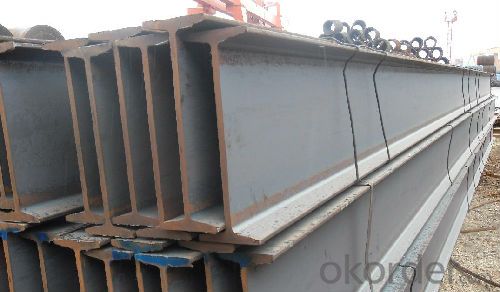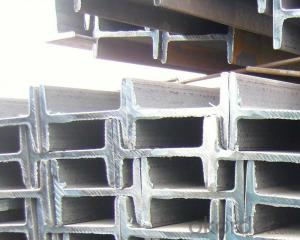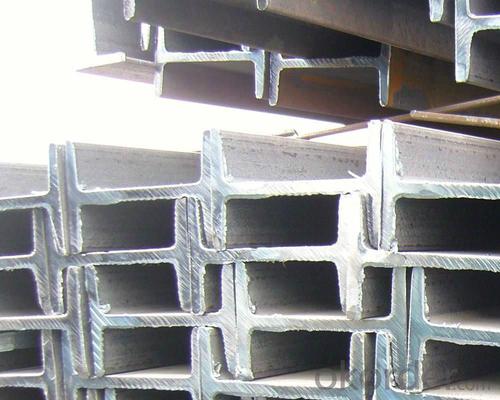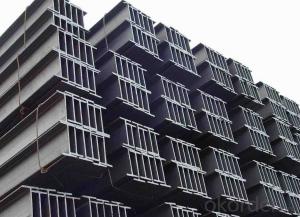IPEAA High Quality Hot Rolled 80MM-270MM S235JR
- Loading Port:
- Tianjin
- Payment Terms:
- TT or LC
- Min Order Qty:
- 25 m.t.
- Supply Capability:
- 10000 m.t./month
OKorder Service Pledge
OKorder Financial Service
You Might Also Like
Product Applications:
High Quality Hot Rolled IPEAA 80MM-270MM S235JR are ideal for structural applications and are widely used in the construction of buildings and bridges, and the manufacturing, petrochemical, and transportation industries.
Product Advantages:
OKorder's High Quality Hot Rolled IPEAA 80MM-270MM S235JR are durable, strong, and resist corrosion.
Main Product Features:
· Premium quality
· Prompt delivery & seaworthy packing (30 days after receiving deposit)
· Corrosion resistance
· Can be recycled and reused
· Mill test certification
· Professional Service
· Competitive pricing
Product Specifications:
Manufacture: Hot rolled
Grade: Q195 – 235
Certificates: ISO, SGS, BV, CIQ
Length: 6m – 12m, as per customer request
Packaging: Export packing, nude packing, bundled
Chinese Standard (H*W*T) | Weight (Kg/m) | 6m (pcs/ton) | Light I (H*W*T) | Weight (Kg/m) | 6m (pcs/ton) | Light II (H*W*T) | Weight (Kg/m) | 6M |
100*68*4.5 | 11.261 | 14.8 | 100*66*4.3 | 10.13 | 16.4 | 100*64*4 | 8.45 | 19.7 |
120*74*5.0 | 13.987 | 11.9 | 120*72*4.8 | 12.59 | 13.2 | 120*70*4.5 | 10.49 | 15.8 |
140*80*5.5 | 16.89 | 9.8 | 140*78*5.3 | 15.2 | 10.9 | 140*76*5 | 12.67 | 13.1 |
160*88*6 | 20.513 | 8.1 | 160*86*5.8 | 18.46 | 9 | 160*84*5.5 | 15.38 | 10.8 |
180*94*6.5 | 24.143 | 6.9 | 180*92*6.3 | 21.73 | 7.6 | 180*90*6 | 18.11 | 9.2 |
200*100*7 | 27.929 | 5.9 | 200*98*6.8 | 25.14 | 6.6 | 200*96*6.5 | 20.95 | 7.9 |
220*110*7.5 | 33.07 | 5 | 220*108*7.3 | 29.76 | 5.6 | 220*106*7 | 24.8 | 6.7 |
250*116*8 | 38.105 | 4.3 | 250*114*7.8 | 34.29 | 4.8 | 250*112*7.5 | 28.58 | 5.8 |
280*122*8.5 | 43.492 | 3.8 | 280*120*8.2 | 39.14 | 4.2 | 280*120*8 | 36.97 | 4.5 |
300*126*9 | 48.084 | 3.4 | 300*124*9.2 | 43.28 | 3.8 | 300*124*8.5 | 40.87 | 4 |
320*130*9.5 | 52.717 | 3.1 | 320*127*9.2 | 48.5 | 3.4 | |||
360*136*10 | 60.037 | 2.7 | 360*132*9.5 | 55.23 | 3 |
FAQ:
Q1: Why buy Materials & Equipment from OKorder.com?
A1: All products offered byOKorder.com are carefully selected from China's most reliable manufacturing enterprises. Through its ISO certifications, OKorder.com adheres to the highest standards and a commitment to supply chain safety and customer satisfaction.
Q2: What makes stainless steel stainless?
A2: Stainless steel must contain at least 10.5 % chromium. It is this element that reacts with the oxygen in the air to form a complex chrome-oxide surface layer that is invisible but strong enough to prevent further oxygen from "staining" (rusting) the surface. Higher levels of chromium and the addition of other alloying elements such as nickel and molybdenum enhance this surface layer and improve the corrosion resistance of the stainless material.
Q3: Can stainless steel rust?
A3: Stainless does not "rust" as you think of regular steel rusting with a red oxide on the surface that flakes off. If you see red rust it is probably due to some iron particles that have contaminated the surface of the stainless steel and it is these iron particles that are rusting. Look at the source of the rusting and see if you can remove it from the surface.


- Q:12 cm GB steel I-beam 5 meters long, how much weight can loft?
- 12 cm standard I-beam 5 meters long attic can do bearing 34.2kNm.
- Q:Can steel I-beams be used to create mezzanine floors?
- Yes, steel I-beams can be used to create mezzanine floors. Mezzanine floors are intermediate floors that are constructed between the main floors of a building, typically creating additional usable space. Steel I-beams are commonly used in the construction industry due to their strength, durability, and ability to support heavy loads. They are ideal for creating mezzanine floors as they can provide the necessary structural support to accommodate the additional weight and ensure the safety of the structure. Additionally, steel I-beams can be customized to fit the specific dimensions and requirements of the mezzanine floor, making them a versatile and efficient choice for this application.
- Q:Are steel I-beams suitable for mezzanine floor constructions?
- Yes, steel I-beams are commonly used in mezzanine floor constructions due to their strength, durability, and ability to support heavy loads. They provide stability and structural integrity, making them a suitable choice for mezzanine floor constructions.
- Q:How do steel I-beams contribute to the overall flexibility of a structure?
- There are several ways in which steel I-beams enhance the flexibility of a structure. Firstly, their distinctive shape and design enable improved weight distribution and load-bearing capacity. The flanges of the I-beam, which are the horizontal sections at the top and bottom, offer resistance against bending forces, while the web, the vertical section connecting the flanges, helps distribute the load evenly. This design permits the I-beam to support heavy loads without sagging or buckling. Moreover, steel I-beams possess a high strength-to-weight ratio, allowing them to endure substantial loads while remaining relatively lightweight. This feature empowers architects and engineers to design structures that are more flexible and versatile, as the I-beams can support heavy loads without the need for excessive amounts of material. Additionally, the lightweight nature of steel I-beams simplifies their transportation and installation, thereby adding to the flexibility of the construction process. Another manner in which steel I-beams enhance the flexibility of a structure is their capacity to span long distances without requiring intermediate supports. This attribute proves particularly advantageous in open floor plans or large industrial spaces where uninterrupted space is desired. The ability of steel I-beams to span long distances eliminates the need for additional columns or walls, thus offering greater flexibility in terms of the structure's layout and functionality. Lastly, steel I-beams exhibit high durability and resistance to various environmental factors, such as fire, moisture, and pests. This durability ensures that the structure remains flexible and reliable over time, withstanding potential damage or wear and tear. The long lifespan of steel I-beams contributes to the overall flexibility of a structure by reducing the need for frequent repairs or replacements, thus offering long-term flexibility in terms of maintenance and cost-effectiveness. In conclusion, steel I-beams enhance the overall flexibility of a structure through their unique design, high strength-to-weight ratio, capacity to span long distances, and durability. These characteristics enable better weight distribution, versatility in design, and long-term reliability, making steel I-beams a vital component in the creation of flexible and adaptable structures.
- Q:How are steel I-beams installed in construction projects?
- Steel I-beams are installed in construction projects by first preparing the foundation to ensure it can support the weight of the beams. The I-beams are then hoisted into position using cranes or other heavy machinery. They are aligned and secured to the foundation or supporting structures using bolts, welding, or other appropriate methods. This installation process ensures the I-beams provide structural integrity and support for the building or structure.
- Q:Own attic, choose I-beam or channel?
- With I-shaped, the I-shaped force is large and firm.I-steel whether ordinary or light, because the section size are relatively high and narrow, so the moment of inertia of section two of the spindle is larger, so it only can be directly used in the web plane bending member or the composition of lattice stress components. It is not suitable for the axial compression member or the bent member perpendicular to the web plane, which has great limitations in its application.
- Q:Can steel I-beams be used in water treatment or wastewater facilities?
- Yes, steel I-beams can be used in water treatment or wastewater facilities. Steel I-beams are commonly used in the construction industry due to their strength, durability, and load-bearing capabilities. In water treatment or wastewater facilities, where heavy equipment and machinery are often installed, steel I-beams provide the necessary structural support. They can be utilized for suspending or attaching various components such as pumps, motors, and tanks. Additionally, steel I-beams can withstand the harsh and corrosive environments commonly found in water treatment or wastewater facilities, making them an ideal choice for such applications.
- Q:What are the different methods of protecting steel I-beams from corrosion?
- There are several methods available for protecting steel I-beams from corrosion. The choice of method depends on factors such as the environment in which the beams will be placed, the expected level of corrosion, and the desired lifespan of the beams. Here are some common methods: 1. Galvanization: This is a popular method where the steel beams are coated with a layer of zinc. The zinc acts as a sacrificial anode, protecting the underlying steel from corrosion. Galvanized steel beams are highly resistant to rust and can withstand harsh environments, making them suitable for outdoor applications. 2. Protective coatings: Another effective method is applying protective coatings on the surface of the steel beams. These coatings can be epoxy-based, polyurethane-based, or other specialized coatings designed to provide a barrier against moisture and corrosive substances. The thickness and type of coating depend on the specific requirements of the project. 3. Cathodic protection: This method involves the use of a sacrificial anode or an impressed current system to protect the steel beams from corrosion. In sacrificial anode systems, a more reactive metal, such as zinc or aluminum, is connected to the steel beams. The anode corrodes instead of the steel beams, thereby protecting them. Impressed current systems involve the use of an external power source to create an electric current that counteracts the corrosion process. 4. Stainless steel construction: Using stainless steel for the I-beams themselves is another effective way to protect against corrosion. Stainless steel contains chromium, which provides a passive protective layer that prevents rust formation. However, stainless steel is generally more expensive than regular steel, so cost considerations may influence its use. 5. Proper maintenance: Regular inspection, cleaning, and maintenance of steel I-beams can significantly extend their lifespan. This involves removing any accumulated dirt, debris, or corrosive substances, and promptly repairing any damaged or deteriorated protective coatings. Regular maintenance can help identify potential corrosion issues early on and prevent further damage. It is important to consider the specific requirements and constraints of each project before selecting a corrosion protection method for steel I-beams. Consulting with experts and conducting a thorough evaluation of the environmental conditions and expected lifespan of the beams will help determine the most suitable method for protecting against corrosion.
- Q:What are the advantages of using steel I-beams?
- There are several advantages of using steel I-beams. Firstly, they have a high strength-to-weight ratio, which means they can support heavy loads while being relatively lightweight. Secondly, steel I-beams are highly durable and resistant to warping or bending, ensuring long-term structural stability. Additionally, they are versatile and can be easily customized to fit specific construction requirements. Moreover, steel I-beams are fire-resistant, making them a safer choice in case of fire hazards. Lastly, steel is a sustainable material as it can be recycled, reducing environmental impact.
- Q:Are there any limitations to the use of steel I-beams in construction?
- There are indeed certain restrictions when it comes to employing steel I-beams in construction projects. Firstly, their weight poses a challenge. Steel I-beams are typically heavy, making transportation and installation more difficult. This can result in increased costs and complexities, particularly in areas with limited resources for heavy lifting equipment or difficult accessibility. Another limitation revolves around the possibility of corrosion. Improper protection may lead to rust and weakening of the steel I-beams over time. This is especially problematic in environments with high humidity, exposure to saltwater, or chemical pollutants. Regular maintenance and the application of protective coatings are necessary to prevent corrosion and ensure the longevity of the I-beams. Furthermore, steel I-beams have limitations in terms of their span length. The longer the span, the greater the likelihood of deflection under load, compromising the structural integrity and stability of the building. In such cases, additional supports or alternative structural solutions may be required to overcome this limitation. Additionally, steel I-beams possess limited fire resistance. High temperatures can cause the steel to lose strength and structural integrity. To mitigate this limitation and guarantee the safety of occupants, fire protection measures such as fire-resistant coatings or the incorporation of fireproofing materials are imperative. Lastly, steel I-beams are susceptible to thermal expansion and contraction. Extreme temperature variations, like those experienced in regions with hot summers and cold winters, can cause the steel to expand and contract, potentially resulting in structural issues. Properly implemented expansion joints and design considerations are necessary to accommodate these thermal movements. Despite these limitations, steel I-beams continue to be extensively used in construction due to their strength, durability, and cost-effectiveness. However, it is crucial to acknowledge these limitations and address them appropriately during the design and construction process to ensure the safety and longevity of the structure.
1. Manufacturer Overview |
|
|---|---|
| Location | |
| Year Established | |
| Annual Output Value | |
| Main Markets | |
| Company Certifications | |
2. Manufacturer Certificates |
|
|---|---|
| a) Certification Name | |
| Range | |
| Reference | |
| Validity Period | |
3. Manufacturer Capability |
|
|---|---|
| a)Trade Capacity | |
| Nearest Port | |
| Export Percentage | |
| No.of Employees in Trade Department | |
| Language Spoken: | |
| b)Factory Information | |
| Factory Size: | |
| No. of Production Lines | |
| Contract Manufacturing | |
| Product Price Range | |
Send your message to us
IPEAA High Quality Hot Rolled 80MM-270MM S235JR
- Loading Port:
- Tianjin
- Payment Terms:
- TT or LC
- Min Order Qty:
- 25 m.t.
- Supply Capability:
- 10000 m.t./month
OKorder Service Pledge
OKorder Financial Service
Similar products
New products
Hot products
Hot Searches
Related keywords


































